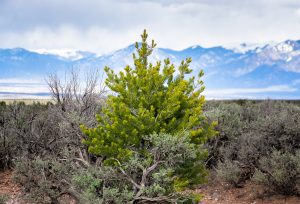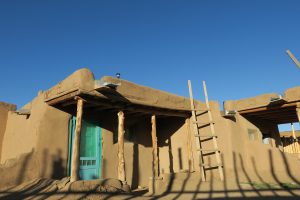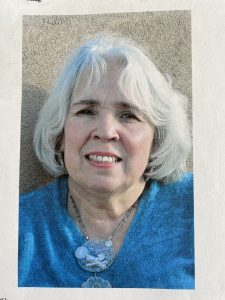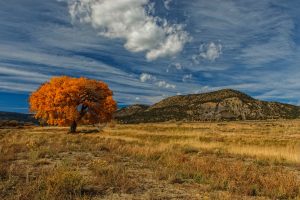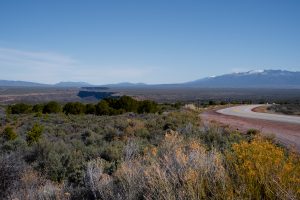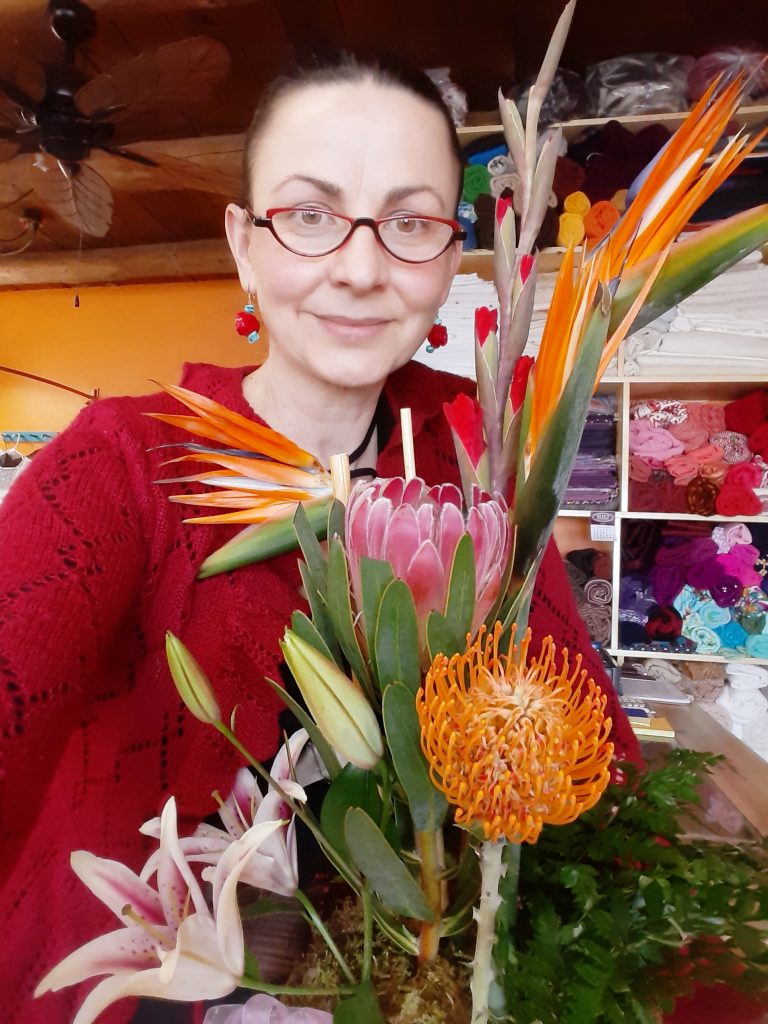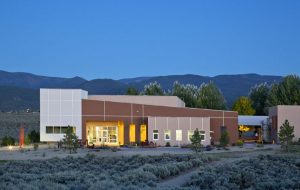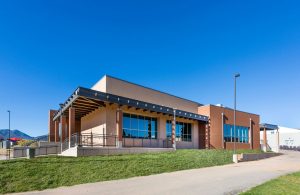Covid Crisis Pushes Hispanic Center Toward a Futuristic Economy

Index of Taos County, New Mexico
An Overview of Taos County, Then and Now
Taos County as a Hispanic Center
Tackling Compounding Crises in New Disaster Group
Technology’s Role in Transforming Taos
Small Business Owners Grapple with Fear and Uncertainty
New Views of Education and Workforce Development
When Covid-19 hit the United States last spring, no place escaped its impacts, but some communities were hit very hard — particularly ones that rely on tourism to thrive, such as Taos County, New Mexico. Like the rest of the country, Taos County’s unemployment rate spiked in April, to 16.5%, but then experienced a second larger hit in July, reaching a rate of 18%. And the hardship happened in a community that’s never fully recovered from the Great Recession.
But the last year has not been a time of sinking into despair for Taos County. Rather, it has been a time to imagine what’s next and for residents to take up key questions, including: How can Taos grow beyond the tourism industry, without abandoning it? How can closing technological and educational inequities and opening more workforce development options improve its trajectory? This is work grounded in the community’s complex racial and ethnic identity, its social challenges, and its cornerstone position in the American landscape.
An Overview of Taos County, Then and Now
While the Rio Grande River and its tributaries are essential features of Taos County — which covers 2,204 square miles in northern New Mexico’s high desert — for centuries populations in these parts have relied on their ingenuity to manage access to water, an irregular resource in the North American West. The need for water, considered a life force for survival and not a commodity, impelled the creation of a commons. Residents managed the unique acequia system, irrigation canals designed to share water for agriculture in an arid land.
Today, Taos County (pop. 32,723) remains rural, with both small-town and frontier attributes. The acequia culture has evolved; 55 now operate, each run by a water sheriff (the mayordomo) and three commissioners, making the acequia the smallest unit of democratic governance in the U.S. At the same time, daily business transactions often rest on old familial and cultural connections.
In some ways, Taos County, characterized as a Hispanic Center, holds an uneasy coexistence of three major cultures — Pueblo, Spanish, and Anglo. Populations have been trading; fighting; and negotiating land disputes, territorial sovereignty, and socioeconomic challenges for hundreds of years. The array of native tribes and the intermixing among groups are key to this diverse cultural history. For example, Indo-Hispano people included genízaros (Native Americans taken into Hispano villages as indentured servants through war or ransom); mestizos (a term from the colonial era for people of mixed race, especially of Spanish and indigenous descent); and mexicanos.
The Taos Valley has always been a nexus for trade, travel, and settlement, according to the Town of Taos. Archeological evidence points to human movement in the Valley for the past 9,000 years, at least. The ancestors of the Pueblo were the first to have settled here, around 900 AD. Taos Pueblo — made up of dwellings and ceremonial buildings — is thought to have been constructed in the 1300s. In the 1500s, Spanish conquistadors colonized this land, where descendants remain to this day. In the 1800s, Mexico ruled for a time after winning independence from Spain, then the United States officially claimed this territory in 1850. Taos became one of the original nine counties in New Mexico Territory in 1852, after which New Mexico became a state in 1912.
The Taos community has shown a continuous ability to reinvent itself — all while being a diverse spiritual center. It’s been an agricultural bastion and in the 1960s New Mexico’s breadbasket. Its art colony has been celebrated for more than a century. The ski business began developing in the 1950s, opening up new residential and commercial opportunities and bringing in more transplants. Amid the growth, poverty has been inescapable. It’s not uncommon to see a multimillion-dollar mansion next to a trailer home.
Recently, the economic disparity between Taos’ year-round businesses and the tourist-based economy has been exacerbated by the Covid-19 pandemic. Local leaders and banks see this in the experiences of small business owners, many of whom cannot obtain financial assistance to maintain their traditional livelihoods, or even afford a home. A community document in March 2021 noted Taos County’s “high levels of poverty, food insecurity, lack of affordable housing, unmet mental health and medical needs, substance abuse, unstable employment and educational inequities.” The county’s median household income stands at $43,000, below the national median, but that belies demographic disparities. For Hispanics, the median income is $33,000; for Native Americans, it’s $30,700; for whites, it’s $47,000.
Three years ago, Taos County was identified as one of America’s most vulnerable communities “most likely to need support before, during, and after a hazardous event,” according to the community document. The U.S. Centers for Disease Control scored Taos 88 out of 100 on the social vulnerability index. That may be partly because trust in institutions and among individuals is low. Consider the 2020 census, for which Taos County had a self-response rate of 37%, compared with the U.S. rate of 67%. This is worrisome because census results help determine how the federal government will distribute money to states and local governments.
If the past year of cascading crises has had any silver lining, it may be that the community has been forced to become more tech savvy, and started openly and communally confronting long-standing social ills, like homelessness and mental health. As Taos County residents continue to tap their inner and communal resources, they are emerging with hard-earned lessons from the pandemic to reimagine their community and work together once more.
Taos County as a Hispanic Center
Taos County is 57% Hispanic or Latino, 36% white, and 8% American Indian and Alaskan Native, according to the latest U.S. Census Bureau statistics. The clearest way Taos stands out from Hispanic Centers across the U.S. is its older population: 28% of Taos County residents are 65 years and older, whereas the Hispanic Centers’ median 65-and-older population stands at 15%.
In many other ways, Taos is similar to its county type. For instance, like many Hispanic Centers, Taos County is a place of extremes and disparities, as illustrated by traditional health and socioeconomic markers. The premature death rate is 9,600, according to the 2021 County Health Rankings, which includes deaths through 2019. But the outcomes are much better for whites at 6,300 than for Hispanics at 10,800. This compares with Hispanic Centers’ rate at 7,604.
Economic statistics also show the community’s stratification. The income inequality rate is 5.3, that is the ratio of household income at the 80th percentile to income at the 20th percentile. That’s higher than the median of Hispanic Centers, which is 4.4. The top performing U.S. counties have a rate of 3.7.
Many residents live in substandard housing conditions. In fact, 17% have at least one of four housing problems: overcrowding, high housing costs, lack of kitchen facilities, or lack of plumbing facilities. And 12% of residents face a severe housing cost burden, spending 50% or more of their household income on housing. That’s similar to Hispanic Centers, where 16% experience severe housing problems, and 10% have a severe housing cost burden.
Family life is filled with social and economic challenges. The child poverty rate for the whole county is 25%, but this rate differs markedly by race and ethnicity, as shown in the chart below. The percentage of children in one-parent homes stands at 39%, which is much higher than the 25% median for Hispanic Centers.
Education, too, is an area with room for improvement. While 90% complete high school, just 74% graduate in four years with their ninth-grade cohort. A majority, 59%, of adults ages 25 to 44 have some college experience. That compares favorably to Hispanic Centers, where it’s 47%. However, in the top performing counties, 73% of adults have some college experience.
Tackling Compounding Crises in New Disaster Group
Because Taos County is so close to affluent Santa Fe, a false perception circulates that it’s well-off. The truth: After the 2008-09 Great Recession, it took Taos about five years to start crawling out of hardship, residents say. Through the suffering, they’ve learned they need to help themselves in times of crisis.
So when New Mexico declared a state of emergency because of Covid-19 in March 2020, a group of public and private sector community leaders in Taos responded in a novel way for the area: They formed the Enchanted Circle Community Organizations Active in Disaster. COAD is a well-regarded leadership model in disaster management, operating with all partner organizations as equals.
Anchor COAD entities include Kit Carson Electric Cooperative, Holy Cross Hospital, and the Taos Community Foundation. Before the COAD, community leaders worked in their silos and didn’t communicate regularly, says the Foundation’s Executive Director Lisa O’Brien. This time, they’ve convened weekly virtual meetings, combining sweat equity and pooling their organizations’ resources. They started with the need for testing and social distancing to minimize the virus’s health impacts. As of late May 2021, the county has had 1,687 cases and 53 deaths from Covid-19, according to USA Facts.
Since March 2020, the COAD has also been taking on many social problems: bringing food to residents and helping them pay their bills. O’Brien shares how generous the Taos community has been. Since April 2020, the Taos Community Foundation has raised about $1 million and counting, she says, including more money from new and small donors. The generosity is not just financial. “We built out a volunteer hub that … we anticipate will be in the community for a long time, even once we’re out of pandemic world,” O’Brien says. As of January 2021, 1,011 households in Taos County were in arrears for electricity with a debt of more than $400,000, according to Kit Carson Electric Cooperative’s data.
As the weeks passed, the COAD brought up the community’s high suicide rate and mental health concerns, leading to further difficult discussions about workforce and housing problems, says Luis Reyes, a resident of Taos County, CEO of Kit Carson Electric Cooperative in northern New Mexico, and a key member of the COAD. For some, couch surfing at friends’ homes is a way of life. Reyes pointed out that the group’s pressure is making affordable housing a priority for local leaders and policymakers.
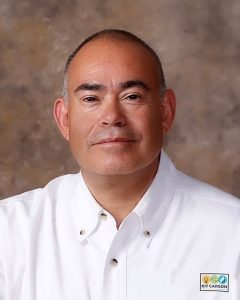
“That becomes the silver lining, even though those are negative things, we still have to bring them to light to see if we can make our community stronger,” Reyes stresses.
In the audio clip below, Luis Reyes describes how the COAD has filled a need, helping residents discuss social problems in Taos County and how to move forward collectively.
The group still meets once a week and members would like to continue as the pandemic recedes. “From my perspective, there’s been some just incredible intangible things, which is we’ve had relationship building across the table, and the level of trust has just intensified,” O’Brien says. The COAD is being bolstered by the implementation of the American Rescue Plan Act of 2021. Taos County expects to receive $6.4 million while the town of Taos (the county seat of 5,929 people) expects about $1 million to address community needs.
An underlying theme of these meetings: the need for a more educated workforce and population. The COAD’s focus has spurred a push to hire an Economic Development Coordinator. A key question residents have been wrestling with: “How do you diversify an economy that for over a century has been based on art and tourism?” Reyes says.
Technology’s Role in Transforming Taos
Technology opens possibilities for economic diversification. As the U.S. debates the merits of the Biden administration’s $2.25 trillion infrastructure proposal, which includes broadband internet for rural communities, reliable internet access is both a chief concern and an opportunity in Taos.
Kit Carson Electric Cooperative, which serves Taos, Colfax, and Rio Arriba counties, has been working on this for more than 20 years. In 2005, the cooperative received a grant and the community passed a technology bond to connect Taos schools to high-speed internet via fiber optic cables. In 2009, the community came together to apply for a broadband infrastructure program grant in the American Recovery and Reinvestment Act. The cooperative received $64 million to implement broadband access for its members, and by 2015, had built out the backbone infrastructure, including 4,000 drops, aka, connections.
The area has many physical and cultural challenges to maneuver around, according to Reyes. For one, the terrain makes digging hard. Situated in the Southern Rockies, Taos has an elevation of about 7,000 feet. The Sangre de Cristo range in the eastern part of the county includes mountainsides stretching above 10,000 feet. The building season lasts just six months, from April 1 to October 1. But construction isn’t possible during the irrigation season in May and June because the area floods. Additionally, the Pueblos close for ceremonies and special events, further shortening the time to work.
Through persistence, Kit Carson Electric Cooperative has set up 9,000 connections — offering 1G service to every connection. The cooperative just received $26 million in grants for another 7,000 drops, and this year outfitted 2,500 homes and businesses with internet access, more than usual. Its goal is to connect all 30,000 members to high-speed internet by 2025. A 5G pilot to residences and businesses is in progress; a 10G pilot has been identified.
Notwithstanding the progress, many still don’t have consistent access. U.S. Census 2019 data showed 67% of households in the county with broadband subscriptions. Many families struggle with spottiness or poor bandwidth. The cooperative has created programs for lower-income families, and during Covid-19 provided connections to students and state employees through common drop areas, Reyes says.
The availability of high-speed technology continues to alter the county’s demographics and culture. Broadband allows many out-of-towners to extend their stays. For years, retirees and second-home buyers have flocked to Taos because of its quality of life and outdoor amenities, while many other residents have multigenerational ties to the area. Sometimes newcomers from the East and West Coasts can come on strong and clash with locals’ laid-back natures, residents say. Meanwhile, many youth have been permanently leaving Taos after high school for more opportunity in the big cities.
More recently, remote work has brought new transplant professionals and families from New York, California, Texas, and elsewhere. The trend has continued in 2020 and 2021, with building happening at a frenetic pace, residents report. There’s a strong sense that the remote-working economy is here to stay, and some in Taos are poised to take advantage. Kit Carson Electric Cooperative services doctors based in Dallas and living in Taos part-time who need the higher internet speeds to read X-rays and other high-capacity medical documents. “We can start creating a niche where you can live in Questa, Red River, or any of our communities, where your neighbors are as close or as far as you want them,” Reyes says.
Small Business Owners Grapple with Fear and Uncertainty
In the meantime, the community has been dealing with a grim reality since last March: The festivals, exhibitions, and fairs that typically attract residents and visitors were cancelled; a lot of stores and restaurants closed. “A fun, colorful place to come to visit has turned into a subdued, lackluster, more ordinary town without the same sense of identity,” says Marilynn Nicholson, an entrepreneur and resident of Taos for more than 30 years.
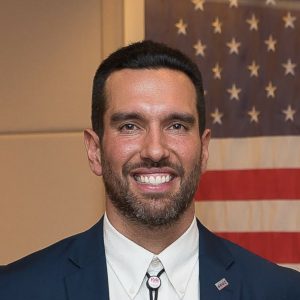
Small businesses have been feeling the pain. Anwar Kaelin, who directs the Small Business Development Center (SBDC) at the University of New Mexico in Taos, plays a key role in Taos County’s entrepreneurial economy — his business advising serving as moral support, a font of knowledge, and a connector to financial resources to keep small business owners going. He estimates that half of businesses are doing much worse than they were pre-pandemic while the other half are doing much better.
During the pandemic, for Covid safety reasons, Kaelin’s face-to-face services through the SBDC have moved exclusively online. Kaelin says an unintended consequence of not being able to meet local clients at their place of business is the inaccessibility of federal disaster assistance programs like the Paycheck Protection Program (PPP) and the Economic Injury Disaster Loan (EIDL) by those who need them the most. Kaelin adds that entrepreneurs in low-income and native communities like Taos are not choosing to hold back on applying, but instead face unreasonable disqualifying financial, logistical, and cultural hurdles, including:
- having difficulty paying their electric and internet bills;
- being unable to afford new laptops, phones, and routers, capable of image and document editing, voice or video conferencing, and the capacity to use them;
- lacking the luxury of time to educate themselves on their eligibility of ever-changing programs at the federal, state, and local levels, some driven by agencies and others through lenders; and
- distrusting systems that have failed them in the past.
Several business owners express gratitude for Kaelin’s help. One of them is Nicholson, who owns a school that offers intensive one week or longer workshops in metalsmithing, lapidary, and jewelry to people worldwide. She also makes her own jewelry and is known as a designer and craftsman working with precious metals and cutting stones for jewelry, which she sells in galleries and exhibits in local museums and shows.
Nicholson describes what the past year has been like. “When Covid closed down everything, I lost my primary income from students who had paid for classes that they intended to travel to Taos to attend during 2020. I also had to turn down inquires for individual study and other workshops during 2020 and 2021 because of restrictions on travel and distancing that make it impossible to personally teach a skilled craft in a confined space. My own jewelry sales have suffered because of the closure of galleries. One of my primary places to show has closed permanently.”
Managing the emotional distress as well as the paperwork has been challenging. “It has been a very difficult, emotional time for many of us who are not used to facing sudden unemployment. Many of us are not familiar with filling out complicated confusing forms and following the instructions that appear to be written in a foreign language. Without help I do not think I could have figured out how to even apply,” Nicholson says.
The abrupt stop has made Nicholson rethink how she wants to live her life, she says. “It has encouraged me to decide to tackle plans that were part of a distant future that may never have happened if I had continued my regular routine. I love my students and teaching, but making my own jewelry was always in the background rather than my primary occupation. I have decided to concentrate on exploring my own ideas while I still have the ability and enthusiasm to design and make jewelry. Stepping back from my everyday routine had given me courage to do something different.”
For those still in business, the modicum of activity hasn’t been without anxiety. When tourists visited Taos in the summer and fall, they did not always follow the state’s mask mandates and social distancing restrictions.
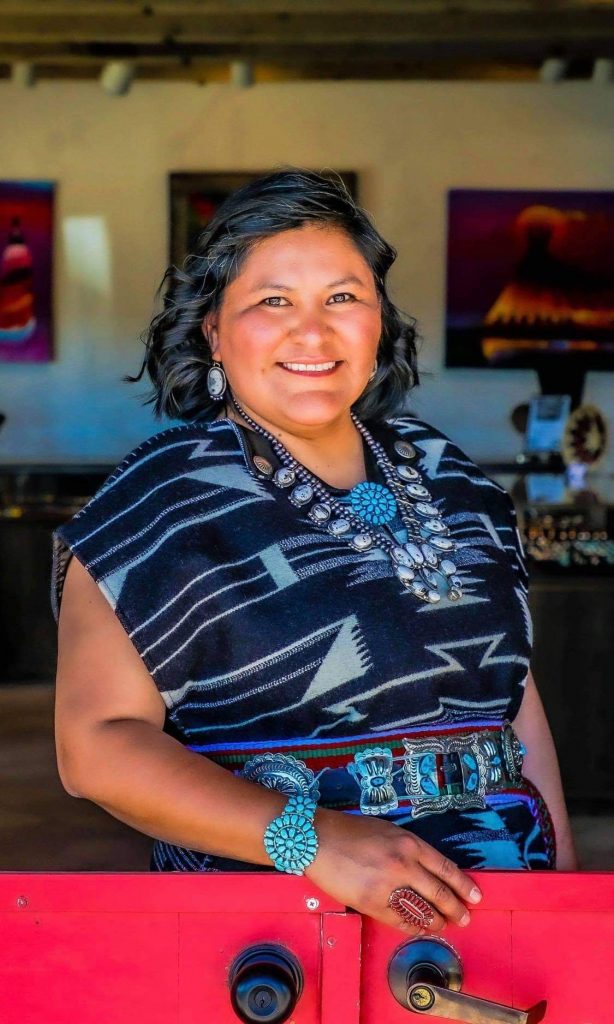
Cherylin Atcitty, a jewelry-maker who opened her Native American gift shop Atcitty’s on Taos Plaza at the beginning of 2020, used her savings to manage between the lockdowns and postal shipping delays. She was ineligible for the federal relief programs because her business was brand-new, she says. Attcity began to look for other financial support, including grant funding.
Last fall, she received a grant from the Regional Development Corporation in New Mexico to expand, and as a tribal member of the Navajo Nation, she qualified for and received a $5,000 hardship grant for artists. Then, in December, Atcitty contracted the virus, she says. “I didn’t use [the hardship grant] to expand my business, like I wanted to do because I was literally struggling to stay alive at that point…I was afraid of getting intubated because I had a lot of family members who actually died from Covid.”
Atcitty is doing much better now. She was recognized by the Small Business Development Corporation as a star client. “I kept pushing forward. I really wanted to advocate for artists…[my business] was to become really self-sustaining to serve as a template so other people can have their own businesses.” Kaelin helped identify funding opportunities. Atcitty also boosted her skills through webinar trainings, and took a course on growing a business through her church, The Church of Jesus Christ of Latter-day Saints. She was awarded a small business stabilization grant from the National Congress of American Indians.
Atcitty says her online ability has improved this year, but she relies on a hotspot for internet access, as grants don’t support this. Atcitty adds that she’s barely been able to sustain her business with paying essential utilities.
Atcitty presses on with purpose and steadfast support. “I really want people to know that the Native Americans are still here and resilient. This business is located right next to the old Kit Carson house. At one point, Kit Carson was instrumental in trying to remove and eradicate the Navajo tribe…Also, my husband [has provided support]. There have been times where there’s been nobody outside and I was crying, and he said, “It’s going to come along. Don’t worry.’”
“The other thing was just trying to not be stagnant, [whether] moving offline, or trying to be more observant of what the customers need and want, and just trying something new all the time.” Next steps, she says, are getting internet access and putting up a website. Longer-term, Attcity seeks to increase her inventory, work with more artists, and help other small businesses.
Some owners, like Ki Holste, pastry chef and co-owner of Sugar Nymphs Bistro, in Peñasco, about 45 minutes from Taos, have seen business pick up this spring. New Mexico has been leading the nation in its vaccination efforts, and as of late May, 44% of Taos County residents have been fully vaccinated. Holste and others are not necessarily requiring vaccines for employees or customers, and vaccine skepticism, sometimes due to misinformation, surfaces in conversations. As entrepreneurs turn toward hiring again, they face the problems they did before the pandemic: employee skill gaps and frequent turnover.
Kamila Rael, who owns European Alterations and Tailoring, in Taos, has also noticed an uptick in shop traffic since early April. She’s applied for a $2,000 grant to develop a website. But the hiatus as well as the difficulty of hiring good workers have made her rethink what’s next. An experienced costume designer who’s worked in the TV/film industry in Los Angeles and for shows in Las Vegas, Rael considers taking her talent to the ballooning film production industry in Santa Fe or Albuquerque, where Netflix and NBCUniversal have announced expansion plans — after her daughter moves to California for college this fall.
New Views of Education and Workforce Development
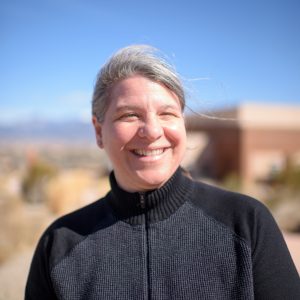
Before the pandemic, 90% of classes were face-to-face and 10% were remote. This past year, the school flipped the ratio. Digital media arts, healthcare, and holistic and healing arts programs (including yoga and integrative medical massage) have been popular during the pandemic, says Randi Archuleta, Dean of Instruction and Department Chair of Social and Behavioral Sciences.
As the school community constructs a new normal, Archuleta wants to focus on lessons learned. She’s realized flexibility and empathy are paramount. “The biggest concern I have had all year is to communicate this with and to faculty. If a student says their internet is down, and you live in Taos, your presumption needs to be that’s absolutely correct. Or you have five people in your household and your calls are dropped,” she says. “This may be true for the faculty as well!”
The school is returning with a hybrid model, giving students choices of face-to-face or remote learning for most subjects. “I think people are going to be a little hesitant to go back to being in physical proximity of each other,” Archuleta says, adding she hopes providing more options will attract students from across the state. She is also pushing for more emphasis on the trades, including culinary arts and hospitality, CDL, general construction and woodworking, and other workforce-related programs.
In the clip below, Randi Archuleta describes how UNM-Taos is working to meet students’ non-academic needs.

Echoing the Dean is Victoria Santistevan Gonzales, Department Chair of Professional Skills and Community Engagement at UNM’s Taos branch, where she specializes in workforce development and career technical education. She says many students work two or three jobs, perhaps at the ski resorts or restaurants, in addition to child rearing. Gonzales aims to expand students’ options, pointing out that those who are skilled in the trades can earn between $40 and $60 an hour. “I hope to continue providing opportunities for our young people, especially if they are not interested in going on to a four-year education. We want them to stay here in Taos and enroll in courses where they can find gainful employment through the trades or entrepreneurship or the digital economies,” she says.
After a year of remote learning, the UNM-Taos community has just scratched the surface of the digital frontier. Recently, UNM-Taos leaders began revamping the school’s current IT certificate, working with industry experts who are redesigning the curriculum to include stackable credentials and topics such as AI and cloud-based computing. “UNM-Taos intends to provide instruction that will empower students to be on the cutting edge,” Gonzales says. She hopes the school will debut new curriculum by fall 2022.

